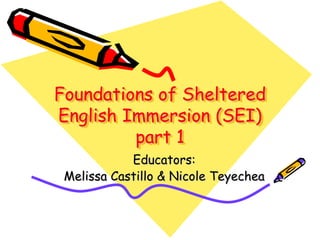
Foundations Of Sheltered English Immersion (Sei) Elementary
- 1. Foundations of Sheltered English Immersion (SEI) part 1 Educators: Melissa Castillo & Nicole Teyechea
- 2. AZ’s Professional Teacher Standard • Standard 8: The teacher demonstrates current professional knowledge sufficient to effectively design and plan instruction, implement and manage instruction, create and maintain an appropriate learning environment, and assess student learning. – 4. Learning theories, subject matter, curriculum development, and student development and how to use this knowledge in planning instruction to meet curriculum goals.
- 3. Content Objectives PWBAT demonstrate knowledge of second language acquisition learning theory by identifying and reviewing basic concepts of second language acquisition. PWBAT demonstrate comprehension of second language acquisition learning theory by matching activities to Cummins BICS and CALPS quadrant.
- 4. Language Objectives PWBAT demonstrate analysis of second language acquisition by discussing factors that are research based. PWBAT demonstrate synthesis of second language acquisition learning theory by writing academic tasks that provide clues for students to understand what is expected.
- 5. What do you already know? In your packet for Foundations of Structured English Immersion… • Take a few minutes to answer this T/F on Myths of Second Language Acquisition. • Try your best… • Save it and we will return to it within the hour.
- 6. WHY SEI? Fact: This is nothing new! Read about the History of Bilingual education. • Highlight the major events • Be prepared to share when we create a group timeline to chart the circumstances that brought us here today.
- 7. What Factors Do You Believe Affect Second Language Acquisition? • Share responses with each other at your table and be ready to share in whole group (5 minutes)
- 8. Factors Affecting Second Language Acquisition 1. Motivation 2. First language development and proficiency 3. Language distance and attitude 4. Access to the language 5. Age 6. Personality and learning style 7. Peers and role models 8. Quality of instruction 9. Cultural background
- 9. How Does Each Factor Affect Second Language Acquisition? Jigsaw Activity • Read ERIC Digest (5minutes) • Count off by 9 • On chart paper list your ideas & responses regarding your language acquisition factor (what does this article tell us? Use your experiences as well.) • Be ready to share with whole group (10 minutes)
- 10. What is the Difference Between Academic and Social Language? •Cognitive Academic Language Proficiency (CALP) •Basic Interpersonal Communication Skills (BICS) A theory by Jim Cummins
- 11. Key words in getting Cummins’ Idea • Context-Embedded: Provides many cues for the learner to access information (realia, video, plays, illustrations) • Context-Reduced: Learner must relay on language to access information (lecture, reading a text, worksheets)
- 12. more Key words in getting Cummins’ Idea • Cognitively demanding: Learner must have enough background knowledge to scaffold new ideas that are academically challenging. – (BICS, CALPS, Second Language Acquisition Theory) – Bloom’s Levels: synthesizing, evaluating, inferring • Cognitively undemanding: Language required is social and not specialized. – (What color is an apple?) – Bloom’s Levels: Knowledge
- 13. Cummins’ Model of Academic Language Cummins’ Context Embedded Context Reduced Model Cognitively A Which activity fits C Which activity Undemanding here? fits here? Cognitively B D Which activity Which activity fits Demanding fits here? here? Organize your activities to match the Cummins’ quadrants. Be ready to share in 2 minutes.
- 14. Cummins’ Model of Academic Language Cummins’ Context Embedded Context Reduced Model Cognitively A Points to C Tells a story about Undemanding classroom items their childhood Cognitively B Uses graphic organizers D Reads the textbook Demanding to identify main points and answers of reading passage questions at the end of the chapter
- 15. BICS (Basic Interpersonal Communication Skills) Levels would include: 1-2 years to acquire • Intro • Beginning Students need: Students demonstrate: • Visuals Meaningful and context embedded • TPR Social language • Hands-on Cognitively undemanding • Natural Approach First levels of Bloom’s Taxonomy • Modeling (Knowledge, Comprehension, • Group work Application)
- 16. CALP (Cognitive Academic Language Proficiency) Levels would include: 5-7 years to acquire • Intermediate • Advanced • Transitional Students Demonstrate: • Ability to read (high School text) • Listening, speaking, reading and writing skills in content area • Critical thinking and questioning skills • High levels of Blooms (classifying, synthesizing, evaluating, and inferring) (We must remember however that they still can and should benefit from the use of the strategies previously shared in BICS)
- 17. Converting Academic Tasks from D to B In pairs or groups choose one of the four activities on BLM# 6 and convert the Context Reduced to Context Embedded. (from quadrant D to B) Be sure to keep the cognitive demand! We will share in FIVE minutes!
- 18. Did we meet our objectives? 1. PWBAT demonstrate knowledge of second language acquisition learning theory by identifying and reviewing basic concepts of second language acquisition. 2. PWBAT demonstrate analysis of second language acquisition by discussing factors that are research based. 3. PWBAT demonstrate comprehension of second language acquisition learning theory by matching activities to Cummins BICS and CALPS quadrant. 4. PWBAT demonstrate synthesis of second language acquisition learning theory by writing academic tasks that provide clues for students to understand what is expected. Which numbers are language objectives? What words support your response?
- 19. Back to the Myths T/F • Let’s review
- 20. Time for a break! • Take 10 minutes!